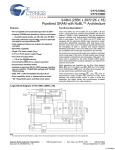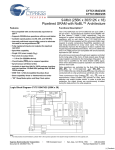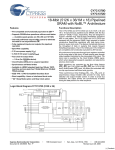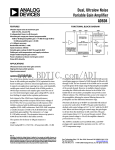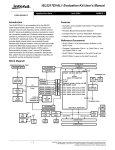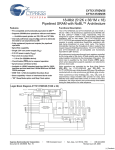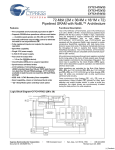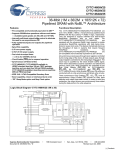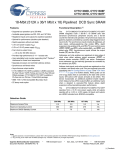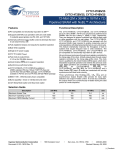Download Cypress Semiconductor CY7C1330AV25 Specifications
Transcript
CY7C1330AV25 CY7C1332AV25 PRELIMINARY 18-Mbit (512K x 36/1Mbit x 18) Pipelined Register-Register Late Write Features Functional Description • Fast clock speed: 250, 200 MHz • Fast access time: 2.0, 2.25 ns • Synchronous Pipelined Operation with Self-timed Late Write • Internally synchronized registered outputs eliminate the need to control OE The CY7C1330AV25 and CY7C1332AV25 are high performance, Synchronous Pipelined SRAMs designed with late write operation. These SRAMs can achieve speeds up to 250 MHz. Each memory cell consists of six transistors. Late write feature avoids an idle cycle required during the turnaround of the bus from a read to a write. • Single WE (READ/WRITE) control pin All synchronous inputs are gated by registers controlled by a positive-edge-triggered Clock Input (K). The synchronous inputs include all addresses (A), all data inputs (DQ[a:d]), Chip Enable (CE), Byte Write Selects (BWS[a:d]), and read-write control (WE). Read or Write Operations can be initiated with the chip enable pin (CE). This signal allows the user to select/deselect the device when desired. • Individual byte write (BWS[a:d]) control (may be tied LOW) Power down feature is accomplished by pulling the Synchronous signal ZZ HIGH. • Common I/O Output Enable (OE) is an asynchronous input signal. OE can be used to disable the outputs at any given time. • 2.5V core supply voltage • 1.4–1.9V VDDQ supply with VREF of 0.68–0.95V — Wide range HSTL I/O Levels • Single Differential HSTL clock Input K and K • Asynchronous Output Enable Input • Programmable Impedance Output Drivers • JTAG boundary scan for BGA packaging version • Available in a 119-ball BGA package (CY7C1330AV25 and CY7C1332AV25) Four pins are used to implement JTAG test capabilities. The JTAG circuitry is used to serially shift data to and from the device. JTAG inputs use LVTTL/LVCMOS levels to shift data during this testing mode of operation. Configuration CY7C1330AV25 – 512K x 36 CY7C1332AV25 – 1M x 18 Logic Block Diagram Clock Buffer D Data-In REG. CE Q (2stage) OUTOUT REGISTERS and LOGIC K,K Ax CE 512Kx36 1Mx18 CONTROL and WRITE LOGIC DQx MEMORY ARRAY WE BWSx ZZ OE AX DQX BWSX 512Kx36 X = 18:0 X = a, b, c, d X = a, b, c, d 1Mx18 Cypress Semiconductor Corporation Document No: 001-07844 Rev. *A • 198 Champion Court • X = 19:0 X = a, b X = a, b San Jose, CA 95134-1709 • 408-943-2600 Revised September 20, 2006 [+] Feedback CY7C1330AV25 CY7C1332AV25 PRELIMINARY Selection Guide CY7C1330AV25-250 CY7C1332AV25-250 CY7C1330AV25-200 CY7C1332AV25- 200 Unit 2.0 2.25 ns Maximum Access Time Maximum Operating Current 600 550 mA Maximum CMOS Standby Current 280 260 mA Pin Configurations 119-Ball BGA (14 x 22 x 2.4 mm) CY7C1330AV25 (512K x 36) 1 2 3 4 5 6 7 A VDDQ A A NC A A VDDQ B C D E F G H J K L M N P NC NC DQc A A DQc A A VSS NC VDD ZQ A A VSS A A DQb NC NC DQb R T U DQc DQc VSS CE VSS DQb DQb VDDQ DQc VSS OE VSS DQb VDDQ DQc DQc BWSc NC BWSb DQb DQb DQc VDDQ DQc VDD VSS VREF NC VDD VSS VREF DQb VDD DQb VDDQ DQd DQd DQd DQd VSS BWSd K K VSS BWSa DQa DQa DQa DQa VSS WE VSS DQa VDDQ VDDQ DQd DQd DQd VSS A0 VSS DQa DQa DQd DQd VSS A1 VSS DQa DQa NC A M1 VDD M2 A NC NC NC A A A ZZ VDDQ TMS TDI TCK TDO NC NC VDDQ CY7C1332AV25 (1M x 18) 1 2 3 4 5 6 7 A VDDQ A A NC A A VDDQ B C D E F G H J K L M N P NC NC DQb A A NC A A VSS NC VDD ZQ A A VSS A A DQa NC NC NC R T U Document No: 001-07844 Rev. *A NC DQb VSS CE VSS NC DQa VDDQ NC VSS OE VSS DQa VDDQ NC DQb BWSb NC NC NC DQa DQb VDDQ NC VDD VSS VREF NC VDD VSS VREF DQa VDD NC VDDQ NC DQb DQb NC VSS NC K K VSS BWSa NC DQa DQa NC VDDQ DQb VSS WE VSS NC VDDQ DQb NC VSS A0 VSS DQa NC NC DQb VSS A1 VSS NC DQa NC A M1 VDD M2 A NC NC A A NC A A ZZ VDDQ TMS TDI TCK TDO NC VDDQ Page 2 of 19 [+] Feedback CY7C1330AV25 CY7C1332AV25 PRELIMINARY Pin Definitions I/O Type Description A Name InputSynchronous Address Inputs used to select one of the address locations. Sampled at the rising edge of the K. BWSa BWSb BWSc BWSd InputSynchronous Byte Write Select Inputs, active LOW. Qualified with WE to conduct writes to the SRAM. Sampled on the rising edge of CLK. BWSa controls DQa, BWSb controls DQb, BWSc controls DQc, BWSd controls DQd. WE InputSynchronous Write Enable Input, active LOW. Sampled on the rising edge of CLK. This signal must be asserted LOW to initiate a write sequence and high to initiate a read sequence. K,K InputDifferential Clock CE InputSynchronous Chip Enable Input, active LOW. Sampled on the rising edge of CLK. Used to select/deselect the device. OE InputAsynchronous Output Enable, active LOW. Combined with the synchronous logic block inside the device to control the direction of the I/O pins. When LOW, the I/O pins are allowed to behave as outputs. When deasserted HIGH, I/O pins are tri-stated, and act as input data pins. OE is masked during the data portion of a write sequence, during the first clock when emerging from a deselected state and when the device has been deselected. DQa DQb DQc DQd I/OSynchronous Bidirectional Data I/O lines. As inputs, they feed into an on-chip data register that is triggered by the rising edge of CLK. As outputs, they deliver the data contained in the memory location specified by A[x:0] during the previous clock rise of the read cycle. The direction of the pins is controlled by OE and the internal control logic. When OE is asserted LOW, the pins can behave as outputs. When HIGH, DQa–DQd are placed in a tri-state condition. The outputs are automatically tri-stated during the data portion of a write sequence, during the first clock when emerging from a deselected state, and when the device is deselected, regardless of the state of OE. DQ a,b,c,d are 9 bits wide Read Protocol Mode Pins Mode control pins, used to set the proper read protocol. For specified device operation, M1 must be connected to VSS, and M2 must be connected to VDD or VDDQ. These mode pins must be set at power-up and cannot be changed during device operation. ZZ InputAsynchronous ZZ “sleep” Input. This active HIGH input places the device in a non-time critical “sleep” condition with data integrity preserved. ZQ Input Output Impedance Matching Input. This input is used to tune the device outputs to the system data bus impedance. Q[x:0] output impedance are set to 0.2 x RQ, where RQ is a resistor connected between ZQ and ground. Alternately, this pin can be connected directly to VDDQ, which enables the minimum impedance mode. This pin cannot be connected directly to GND or left unconnected. VDD Power Supply M1, M2 Clock Inputs. Used to capture all synchronous inputs to the device. Power supply inputs to the core of the device. For this device, the VDD is 2.5V. VDDQ I/O Power Supply Power supply for the I/O circuitry. For this device, the VDDQ is 1.5V. VREF InputReference Voltage Reference Voltage Input. Static input used to set the reference level for HSTL inputs and Outputs as well as AC measurement points. VSS Ground TDO JTAG serial output Synchronous TDI JTAG serial input Synchronous Serial data-in to the JTAG circuit. Sampled on the rising edge of TCK. TMS Test Mode Select Synchronous This pin controls the Test Access Port state machine. Sampled on the rising edge of TCK. TCK JTAG serial clock NC – Document No: 001-07844 Rev. *A Ground for the device. Should be connected to ground of the system. Serial data-out to the JTAG circuit. Delivers data on the negative edge of TCK. Serial clock to the JTAG circuit. No connects. Page 3 of 19 [+] Feedback PRELIMINARY CY7C1330AV25 CY7C1332AV25 Introduction Ax is loaded into the Address Register. The write signals are latched into the Control Logic block. Functional Overview The data lines are automatically tri-stated regardless of the state of the OE input signal when a write is detected. This allows the external logic to present the data on DQ and DQP (DQ[a:b] for CY7C1332AV25 and DQ[a:d] for CY7C1330AV25). In addition, the address for the subsequent access (Read/Write/Deselect) is latched into the Address Register (provided the appropriate control signals are asserted). The CY7C1330AV25 and CY7C1332AV25 are synchronouspipelined Late Write SRAMs running at speeds up to 250 MHz. All synchronous inputs pass through input registers controlled by the rising edge of the clock. All data outputs pass through output registers controlled by the rising edge of the clock. Maximum access delay from the clock rise (tCO) is 2.0 ns (250-MHz device). Accesses can be initiated by asserting Chip Enable (CE) on the rising edge of the clock. The address presented to the device will be latched on this edge of the clock. The access can either be a read or write operation, depending on the status of the Write Enable (WE). BWS[d:a] can be used to conduct individual byte write operations. Write operations are qualified by the Write Enable (WE). All writes are simplified with on-chip synchronous self-timed late write circuitry. All operations (Reads, Writes, and Deselects) are pipelined. Pipelined Read Accesses A read access is initiated when the following conditions are satisfied at clock rise: (1) Chip Enable (CE) is asserted active and (2) the Write Enable input signal (WE) is asserted HIGH. The address presented to the address inputs is latched into the Address Register and presented to the memory core and control logic. The control logic determines that a read access is in progress and allows the requested data to propagate to the input of the output register. At the rising edge of the next clock the requested data is allowed to propagate through the output register and onto the data bus within 2.0 ns (250-MHz device) provided OE is active LOW. After the first clock of the read access the output buffers are controlled by OE and the internal control logic. OE must be driven LOW in order for the device to drive out the requested data. During the second clock, a subsequent operation (Read/Write/Deselect) can be initiated. Deselecting the device is also pipelined. Therefore, when the SRAM is deselected at clock rise by one of the chip enable signals, its output will tri-state following the next clock rise. Bypass Read Operation Bypass read operation occurs when the last write operation is followed by a read operation where write and read addresses are identical. The data outputs are provided from the data in registers rather than the memory array. This operation occurs on a byte to byte basis. If only one byte is written during a write operation and a read operation is performed on the same address; then a partial bypass read operation is performed since the new byte data will be from the datain registers while the remaining bytes are from the memory array. Late Write Accesses The Late Write feature allows for the write data to be presented one cycle later after the access is started. This feature eliminates one bus-turnaround cycle which is necessary when going from a read to a write in an ordinary pipelined Synchronous Burst SRAM. Write access is initiated when the following conditions are satisfied at clock rise: (1) CE is asserted active and (2) the write signal WE is asserted LOW. The address presented to Document No: 001-07844 Rev. *A On the next clock rise the data presented to DQ (or a subset for byte write operations, see Write Cycle Description table for details) inputs is latched into the device and the write is complete. The data written during the Write operation is controlled by BWS (BWS[a:d] for CY7C1330AV25 and BWS[a:b] for CY7C1332AV25) signals. The CY7C1330AV25 and CY7C1332AV25 provide byte write capability that is described in the Write Cycle Description table. Asserting the Write Enable input (WE) with the selected Byte Write Select (BWS) input will selectively write to only the desired bytes. Bytes not selected during a byte write operation will remain unaltered. A Synchronous self-timed write mechanism has been provided to simplify the write operations. Byte write capability has been included in order to greatly simplify Read/Modify/Write sequences, which can be reduced to simple byte write operations. Because the CY7C1330AV25/CY7C1332AV25 is a common I/O device, data should not be driven into the device while the outputs are active. The Output Enable (OE) can be deasserted HIGH before presenting data to the DQ inputs. Doing so will tri-state the output drivers. As a safety precaution, DQ is automatically tri-stated during the data portion of a write cycle, regardless of the state of OE. Power-up/Power-down Supply Voltage Sequencing The power-up and power-down supply voltage application recommendations are as follows: Power-up: VSS, VDD, VDDQ, VREF, VIN. Power-down: VIN, VREF, VDDQ, VDD, VSS. VDDQ can be applied/removed simultaneously with VDD as long as VDDQ does not exceed VDD by more than 0.5V. Programmable Impedance An external resistor, RQ, must be connected between the ZQ pin on the SRAM and VSS to allow the SRAM to adjust its output driver impedance. The value of RQ must be 5X the value of the intended line impedance driven by the SRAM, The allowable range of RQ to guarantee impedance matching with a tolerance of ±10% is between 175Ω and 350Ω, with VDDQ=1.5V. The output impedance is adjusted every 1024 cycles to adjust for drifts in supply voltage and temperature.The output buffers can also be programmed in a minimum impedance configuration by connecting ZQ to VDD. Sleep Mode The ZZ input pin is an asynchronous input. Asserting ZZ places the SRAM in a power conservation “sleep” mode. Two clock cycles are required to enter into or exit from this “sleep” mode. While in this mode, data integrity is guaranteed. Accesses pending when entering the “sleep” mode are not considered valid nor is the completion of the operation Page 4 of 19 [+] Feedback CY7C1330AV25 CY7C1332AV25 PRELIMINARY guaranteed. The device must be deselected prior to entering the “sleep” mode. CE must remain inactive for the duration of tZZREC after the ZZ input returns LOW. Cycle Description Truth Table[1, 2, 3, 4, 5] Operation Address Used CE WE BWSx CLK ZZ Deselected External 1 X Begin Read External 0 Begin Write External 0 Sleep Mode X - Comments X L-H 0 I/Os tri-state following next recognized clock. 1 X L-H 0 Address latched. Data driven out on the next rising edge of the clock. 0 Valid L-H 0 Address latched, data presented to the SRAM on the next rising edge of the clock. X X X 1 Power down mode. ZZ Mode Electrical Characteristics Parameter Description Test Conditions IDDZZ Snooze mode standby current ZZ > VIH tZZS Device operation to ZZ ZZ > VIH tZZREC ZZ recovery time ZZ < VIL Min. Max. Unit 128 mA 2tCYC ns 2tCYC ns Write Cycle Descriptions[1, 2] Function (CY7C1330AV25) WE BWd BWc BWb BWa Read 1 X X X X Write Byte 0 – DQa 0 1 1 1 0 Write Byte 1 – DQb 0 1 1 0 1 Write Bytes 1, 0 0 1 1 0 0 Write Byte 2 – DQc 0 1 0 1 1 Write Bytes 2, 0 0 1 0 1 0 Write Bytes 2, 1 0 1 0 0 1 Write Bytes 2, 1, 0 0 1 0 0 0 Write Byte 3 – DQd 0 0 1 1 1 Write Bytes 3, 0 0 0 1 1 0 Write Bytes 3, 1 0 0 1 0 1 Write Bytes 3, 1, 0 0 0 1 0 0 Write Bytes 3, 2 0 0 0 1 1 Write Bytes 3, 2, 0 0 0 0 1 0 Write Bytes 3, 2, 1 0 0 0 0 1 Write All Bytes 0 0 0 0 0 Abort Write All Bytes 0 1 1 1 1 Write Cycle Descriptions[1, 2] Function (CY7C1332AV25) Read Write Byte 0 – DQa Write Byte 1 – DQb Write All Bytes Abort Write All Bytes WE 1 0 0 0 0 BWb X 1 0 0 1 BWa X 0 1 0 1 Notes: 1. X = “Don't Care,” 1 = Logic HIGH, 0 = Logic LOW. BWSx = 0 signifies at least one Byte Write Select is active, BWSx = Valid signifies that the desired byte write selects are asserted, see Write Cycle Description table for details. 2. Write is defined by WE and BWSx. See Write Cycle Description table for details. 3. The DQ pins are controlled by the current cycle and the OE signal. 4. Device will power-up deselected and the I/Os in a tri-state condition, regardless of OE. 5. OE assumed LOW. Document No: 001-07844 Rev. *A Page 5 of 19 [+] Feedback PRELIMINARY CY7C1330AV25 CY7C1332AV25 IEEE 1149.1 Serial Boundary Scan (JTAG) Instruction Register These SRAMs incorporate a serial boundary scan test access port (TAP) in the FBGA package. This port operates in accordance with IEEE Standard 1149.1-1900 but does not have the set of functions required for full 1149.1 compliance. The TAP operates using JEDEC standard 1.8V I/O logic levels. Three-bit instructions can be serially loaded into the instruction register. This register is loaded when it is placed between the TDI and TDO pins as shown in TAP Controller Block Diagram. Upon power-up, the instruction register is loaded with the IDCODE instruction. It is also loaded with the IDCODE instruction if the controller is placed in a reset state as described in the previous section. Disabling the JTAG Feature It is possible to operate the SRAM without using the JTAG feature. To disable the TAP controller, TCK must be tied LOW (VSS) to prevent clocking of the device. TDI and TMS are internally pulled up and may be unconnected. They may alternately be connected to VDD through a pull-up resistor. TDO should be left unconnected. Upon power-up, the device will come up in a reset state which will not interfere with the operation of the device. Test Access Port—Test Clock The test clock is used only with the TAP controller. All inputs are captured on the rising edge of TCK. All outputs are driven from the falling edge of TCK. Test Mode Select The TMS input is used to give commands to the TAP controller and is sampled on the rising edge of TCK. It is allowable to leave this pin unconnected if the TAP is not used. The pin is pulled up internally, resulting in a logic HIGH level. Test Data-In (TDI) The TDI pin is used to serially input information into the registers and can be connected to the input of any of the registers. The register between TDI and TDO is chosen by the instruction that is loaded into the TAP instruction register. For information on loading the instruction register, see the TAP Controller State Diagram. TDI is internally pulled up and can be unconnected if the TAP is unused in an application. TDI is connected to the most significant bit (MSB) on any register. Test Data-Out (TDO) The TDO output pin is used to serially clock data-out from the registers. The output is active depending upon the current state of the TAP state machine (see Instruction codes). The output changes on the falling edge of TCK. TDO is connected to the least significant bit (LSB) of any register. Performing a TAP Reset A Reset is performed by forcing TMS HIGH (VDD) for five rising edges of TCK. This RESET does not affect the operation of the SRAM and may be performed while the SRAM is operating. At power-up, the TAP is reset internally to ensure that TDO comes up in a high-Z state. TAP Registers Registers are connected between the TDI and TDO pins and allow data to be scanned into and out of the SRAM test circuitry. Only one register can be selected at a time through the instruction registers. Data is serially loaded into the TDI pin on the rising edge of TCK. Data is output on the TDO pin on the falling edge of TCK. Document No: 001-07844 Rev. *A When the TAP controller is in the Capture IR state, the two least significant bits are loaded with a binary “01” pattern to allow for fault isolation of the board level serial test path. Bypass Register To save time when serially shifting data through registers, it is sometimes advantageous to skip certain chips. The bypass register is a single-bit register that can be placed between TDI and TDO pins. This allows data to be shifted through the SRAM with minimal delay. The bypass register is set LOW (VSS) when the BYPASS instruction is executed. Boundary Scan Register The boundary scan register is connected to all of the input and output pins on the SRAM. Several no connect (NC) pins are also included in the scan register to reserve pins for higher density devices. The boundary scan register is loaded with the contents of the RAM Input and Output ring when the TAP controller is in the Capture-DR state and is then placed between the TDI and TDO pins when the controller is moved to the Shift-DR state. The EXTEST, SAMPLE/PRELOAD and SAMPLE Z instructions can be used to capture the contents of the Input and Output ring. The Boundary Scan Order tables show the order in which the bits are connected. Each bit corresponds to one of the bumps on the SRAM package. The MSB of the register is connected to TDI, and the LSB is connected to TDO. Identification (ID) Register The ID register is loaded with a vendor-specific, 32-bit code during the Capture-DR state when the IDCODE command is loaded in the instruction register. The IDCODE is hardwired into the SRAM and can be shifted out when the TAP controller is in the Shift-DR state. The ID register has a vendor code and other information described in the Identification Register Definitions table. TAP Instruction Set Eight different instructions are possible with the three-bit instruction register. All combinations are listed in the Instruction Code table. Three of these instructions are listed as RESERVED and should not be used. The other five instructions are described in detail below. Instructions are loaded into the TAP controller during the Shift-IR state when the instruction register is placed between TDI and TDO. During this state, instructions are shifted through the instruction register through the TDI and TDO pins. To execute the instruction once it is shifted in, the TAP controller needs to be moved into the Update-IR state. Page 6 of 19 [+] Feedback PRELIMINARY EXTEST EXTEST is a mandatory 1149.1 instruction which is to be executed whenever the instruction register is loaded with all 0s. EXTEST is not implemented in this SRAM TAP controller, and therefore this device is not compliant to 1149.1. The TAP controller does recognize an all-0 instruction. When an EXTEST instruction is loaded into the instruction register, the SRAM responds as if a SAMPLE/PRELOAD instruction has been loaded. There is one difference between the two instructions. Unlike the SAMPLE/PRELOAD instruction, EXTEST places the SRAM outputs in a High-Z state. IDCODE The IDCODE instruction causes a vendor-specific, 32-bit code to be loaded into the instruction register. It also places the instruction register between the TDI and TDO pins and allows the IDCODE to be shifted out of the device when the TAP controller enters the Shift-DR state. The IDCODE instruction is loaded into the instruction register upon power-up or whenever the TAP controller is given a test logic reset state. SAMPLE Z The SAMPLE Z instruction causes the boundary scan register to be connected between the TDI and TDO pins when the TAP controller is in a Shift-DR state. The SAMPLE Z command puts the output bus into a High-Z state until the next command is given during the “Update IR” state. SAMPLE/PRELOAD SAMPLE/PRELOAD is a 1149.1 mandatory instruction. When the SAMPLE/PRELOAD instructions are loaded into the instruction register and the TAP controller is in the Capture-DR state, a snapshot of data on the inputs and output pins is captured in the boundary scan register. The user must be aware that the TAP controller clock can only operate at a frequency up to 20 MHz, while the SRAM clock operates more than an order of magnitude faster. Because Document No: 001-07844 Rev. *A CY7C1330AV25 CY7C1332AV25 there is a large difference in the clock frequencies, it is possible that during the Capture-DR state, an input or output will undergo a transition. The TAP may then try to capture a signal while in transition (metastable state). This will not harm the device, but there is no guarantee as to the value that will be captured. Repeatable results may not be possible. To guarantee that the boundary scan register will capture the correct value of a signal, the SRAM signal must be stabilized long enough to meet the TAP controller's capture set-up plus hold times (tCS and tCH). The SRAM clock input might not be captured correctly if there is no way in a design to stop (or slow) the clock during a SAMPLE/PRELOAD instruction. If this is an issue, it is still possible to capture all other signals and simply ignore the value of the CK and CK captured in the boundary scan register. Once the data is captured, it is possible to shift out the data by putting the TAP into the Shift-DR state. This places the boundary scan register between the TDI and TDO pins. PRELOAD allows an initial data pattern to be placed at the latched parallel outputs of the boundary scan register cells prior to the selection of another boundary scan test operation. The shifting of data for the SAMPLE and PRELOAD phases can occur concurrently when required—that is, while data captured is shifted out, the preloaded data can be shifted in. BYPASS When the BYPASS instruction is loaded in the instruction register and the TAP is placed in a Shift-DR state, the bypass register is placed between the TDI and TDO pins. The advantage of the BYPASS instruction is that it shortens the boundary scan path when multiple devices are connected together on a board. Reserved These instructions are not implemented but are reserved for future use. Do not use these instructions. Page 7 of 19 [+] Feedback CY7C1330AV25 CY7C1332AV25 PRELIMINARY TAP Controller State Diagram[6] 1 TEST-LOGIC RESET 0 0 TEST-LOGIC/ IDLE 1 1 1 SELECT DR-SCAN SELECT IR-SCAN 0 0 1 1 CAPTURE-DR CAPTURE-IR 0 0 SHIFT-DR SHIFT-IR 0 1 0 1 1 EXIT1-DR 1 EXIT1-IR 0 0 PAUSE-DR 0 0 PAUSE-IR 1 1 0 0 EXIT2-DR EXIT2-IR 1 1 UPDATE-DR 1 0 UPDATE-IR 1 0 Note: 6. The 0/1 next to each state represents the value at TMS at the rising edge of TCK. Document No: 001-07844 Rev. *A Page 8 of 19 [+] Feedback CY7C1330AV25 CY7C1332AV25 PRELIMINARY TAP Controller Block Diagram 0 Bypass Register Selection Circuitry TDI 2 1 0 1 0 Selection Circuitry Instruction Register 31 30 29 . . 2 TDO Identification Register 106 . . . . 2 1 0 Boundary Scan Register TCK TMS TAP Controller TAP Electrical Characteristics Over the Operating Range[7, 8, 9] Parameter Description Test Conditions Min. VOH1 Output HIGH Voltage IOH = −2.0 mA 1.7 2.1 VOH2 Output HIGH Voltage IOH = −100 µA VOL1 Output LOW Voltage IOL = 2.0 mA IOL = 100 µA VOL2 Output LOW Voltage VIH Input HIGH Voltage VIL Input LOW Voltage IX Input and Output Load Current GND ≤ VI ≤ VDD Max. Unit V V 0.7 V 0.2 V 1.7 VDD + 0.3 V –0.3 0.7 V –5 5 µA TAP AC Switching Characteristics Over the Operating Range [10, 11] Parameter Description Min. Max. Unit tTCYC TCK Clock Cycle Time tTF TCK Clock Frequency tTH TCK Clock HIGH 20 ns tTL TCK Clock LOW 20 ns tTMSS TMS Set-up to TCK Clock Rise 5 ns tTDIS TDI Set-up to TCK Clock Rise 5 ns tCS Capture Set-up to TCK Rise 5 ns tTMSH TMS Hold after TCK Clock Rise 5 ns tTDIH TDI Hold after Clock Rise 5 ns 50 ns 20 MHz Set-up Times Hold Times Notes: 7. Minimum voltage equals –2.0V for pulse durations of less than 20 ns. 8. Input waveform should have a slew rate of > 1 V/ns. 9. These characteristics pertain to the TAP inputs (TMS, TCK, TDI and TDO). Parallel load levels are specified in the Electrical Characteristics Table. 10. tCS and tCH refer to the set-up and hold time requirements of latching data from the boundary scan register. 11. Test conditions are specified using the load in TAP AC test conditions. tR/tF = 1 ns. Document No: 001-07844 Rev. *A Page 9 of 19 [+] Feedback CY7C1330AV25 CY7C1332AV25 PRELIMINARY TAP AC Switching Characteristics Over the Operating Range (continued)[10, 11] Parameter Description tCH Min. Capture Hold after Clock Rise Max. Unit 5 ns Output Times tTDOV TCK Clock LOW to TDO Valid tTDOX TCK Clock LOW to TDO Invalid 10 ns 0 ns TAP Timing and Test Conditions[11] ALL INPUT PULSES 1.25V 2.5V 1.25V 50Ω 0V TDO Z0 = 50Ω CL = 20 pF GND tTH (a) tTL Test Clock TCK tTCYC tTMSS tTMSH Test Mode Select TMS tTDIS tTDIH Test Data-In TDI Test Data-Out TDO tTDOV tTDOX Identification Register Definitions Value Instruction Field CY7C1330AV25 CY7C1332AV25 000 000 Revision Number (31:29) Cypress Device ID (28:12) Description Version number. 01011110101100101 01011110101010101 Defines the type of SRAM. Cypress JEDEC ID (11:1) 00000110100 00000110100 ID Register Presence (0) 1 1 Document No: 001-07844 Rev. *A Allows unique identification of SRAM vendor. Indicates the presence of an ID register. Page 10 of 19 [+] Feedback CY7C1330AV25 CY7C1332AV25 PRELIMINARY Scan Register Sizes Register Name Bit Size—CY7C1330AV25 Bit Size—CY7C1332AV25 Instruction 3 3 Bypass 1 1 ID 32 32 Boundary Scan 70 51 Instruction Codes Instruction Code Description EXTEST 000 Captures the Input/Output ring contents. IDCODE 001 Loads the ID register with the vendor ID code and places the register between TDI and TDO. This operation does not affect SRAM operation. SAMPLE Z 010 Captures the Input/Output contents. Places the boundary scan register between TDI and TDO. Forces all SRAM output drivers to a High-Z state. RESERVED 011 Do Not Use: This instruction is reserved for future use. SAMPLE/PRELOAD 100 Captures the Input/Output ring contents. Places the boundary scan register between TDI and TDO. Does not affect the SRAM operation. RESERVED 101 Do Not Use: This instruction is reserved for future use. RESERVED 110 Do Not Use: This instruction is reserved for future use. BYPASS 111 Places the bypass register between TDI and TDO. This operation does not affect SRAM operation. Boundary Scan Order (1 Mbit x 18) Bit # Bump ID Bit # Bump ID Bit # 1 5R 2 6T Bump ID 18 7E 35 1H 19 6D 36 3G 3 4P 20 6A 37 4D 4 6R 21 6C 38 4E 5 5T 22 5C 39 4G 6 7T 23 5A 40 4H 7 7P 24 6B 41 4M 8 6N 25 5B 42 2K 9 6L 26 3B 43 1L 10 7K 27 2B 44 2M 11 5L 28 3A 45 1N 12 4L 29 3C 46 2P 13 4K 30 2C 47 3T 14 4F 31 2A 48 2R 15 6H 32 1D 49 4N 16 7G 33 2E 50 2T 17 6F 34 2G 51 3R Document No: 001-07844 Rev. *A Page 11 of 19 [+] Feedback CY7C1330AV25 CY7C1332AV25 PRELIMINARY Boundary Scan Order (512K x 36) Bit # Bump ID Bit # Bump ID Bit # Bump ID 1 5R 25 6F 49 2H 2 4P 26 7E 50 1H 3 4T 27 6E 51 3G 4 6R 28 7D 52 4D 5 5T 29 6D 53 4E 6 7T 30 6A 54 4G 7 6P 31 6C 55 4H 8 7P 32 5C 56 4M 9 6N 33 5A 57 3L 10 7N 34 6B 58 1K 11 6M 35 5B 59 2K 12 6L 36 3B 60 1L 13 7L 37 2B 61 2L 14 6K 38 3A 62 2M 15 7K 39 3C 63 1N 16 5L 40 2C 64 2N 17 4L 41 2A 65 1P 18 4K 42 2D 66 2P 19 4F 43 1D 67 3T 20 5G 44 2E 68 2R 21 7H 45 1E 69 4N 22 6H 46 2F 70 3R 23 7G 47 2G 24 6G 48 1G Document No: 001-07844 Rev. *A Page 12 of 19 [+] Feedback CY7C1330AV25 CY7C1332AV25 PRELIMINARY DC Input Voltage[7] ................................ –0.5V to VDD + 0.5V Maximum Ratings (Above which the useful life may be impaired. For user guidelines, not tested.) Storage Temperature ................................. –65°C to +150°C Ambient Temperature with Power Applied........................................... –55°C to +125°°C Current into Outputs (LOW)......................................... 20 mA Static Discharge Voltage........................................... > 1500V (per MIL-STD-883, Method 3015) Latch-up Current..................................................... > 200 mA Operating Range Supply Voltage on VDD Relative to GND........ –0.5V to +2.9V Supply Voltage on VDDQ Relative to GND ...... –0.5V to +VDD Range Ambient Temperature VDD VDDQ DC Voltage Applied to Outputs in High-Z State[7] ................................. –0.5V to VDDQ + 0.5V Com’l 0°C to +70°C 2.37V to 2.63V 1.4V to 1.9V Electrical Characteristics Over the Operating Range DC Electrical Characteristics Over the Operating Range Parameter Description Test Conditions VDD Power Supply Voltage VDDQ I/O Supply Voltage VOH1 Output HIGH Voltage[12] Programmable Impedance Mode[14] VOL1 Output LOW Voltage[13] Programmable Impedance Mode[14] VOH2 Output HIGH Voltage IOH = –0.1 mA, Minimum Impedance Mode[15] VOL2 Output LOW Voltage IOL = 0.1 mA, Minimum Impedance Mode[15] VOH3 Output HIGH Voltage IOH = –6.0 mA, Minimum Impedance Mode[15] VOL3 Output LOW Voltage VIH Input HIGH Voltage IOL = 6.0 mA, Minimum Impedance Input LOW IX Input Leakage Current GND ≤ VI ≤ VDDQ IOZ Output Leakage Current GND ≤ VI ≤ VDDQ, Output Disabled VREF Input Reference Voltage Typical value = 0.75V VIN–CLK Max. Unit 2.37 2.63 V 1.4 1.9 V VDDQ/2 VDD V VSS VDDQ/2 V VDDQ – 0.2 VDDQ V VSS 0.2 V VDDQ – 0.4 VDDQ V Mode[15] VSS 0.4 V VREF + 0.1 VDDQ + 0.3 V –0.3 VREF – 0.1 V –1 1 mA Voltage[7] VIL Min. –1 1 mA 0.68 0.95 V Clock Input Reference Voltage –0.3 VDDQ + 0.3 V VDIF–CLK Clock Input Differential Voltage 0.1 VDDQ + 0.3 V VCM–CLK Clock Common Mode Voltage Typical Value =0.75V 0.55 0.95 V IDD VDD Operating Supply VDD = Max., IOUT = 0 mA, f = fMAX = 1/tCYC 250 MHz 600 mA 200 MHz 550 mA Max. VDD, Device Deselected, VIN > VIH or VIN < VIL f = fMAX = 1/tCYC 250 MHz 280 mA 200 MHz 260 mA Max. Unit ISB1 Automatic CE Power-Down Current—TTL Inputs AC Electrical Characteristics Over the Operating Range Parameter Description Test Conditions Min. VIH Input HIGH Voltage VREF + 0.2 – V VIL Input LOW Voltage – VREF – 0.2 V Notes: 12. IOH = (VDDQ/2)/(RQ/5)+15% for 175Ω < RQ < 350Ω. 13. IOL = (VDDQ/2)/(RQ/5)+15% for 175Ω < RQ < 350Ω. 14. Programmable Impedance Output Buffer Mode. The ZQ pin is connected to VSS through RQ. 15. Minimum Impedance Output Buffer Mode: The ZQ pin is connected directly to VSS or VDD. 16. TPower-up: Assumes a linear ramp from 0V to VDD (min.) within 200 ms. During this time VIH < VDD and VDDQ < VDD. Document No: 001-07844 Rev. *A Page 13 of 19 [+] Feedback CY7C1330AV25 CY7C1332AV25 PRELIMINARY Capacitance[17] Parameter Description CIN Input Capacitance CCLK Clock Input Capacitance CI/O Input/Output Capacitance Test Conditions TA = 25°C, f = 1 MHz, VDD = 2.5V VDDQ = 1.5V Max. Unit 5 pF 6 pF 7 pF Thermal Resistance[17] Parameter Description ΘJA Thermal Resistance (Junction to Ambient) ΘJC Thermal Resistance (Junction to Case) Test Conditions BGA Typ. Unit Still Air, soldered on a 4.25 x 1.125 inch, 4-layer printed circuit board 19.7 °C/W 6.0 °C/W AC Test Loads and Waveforms VREF = 0.75V VREF 0.75V VREF OUTPUT Z0 = 50Ω Device Under Test RL = 50Ω VREF = 0.75V ZQ RQ = 250Ω 0.75V R = 50Ω ALL INPUT PULSES 1.25V 0.75V OUTPUT Device Under Test ZQ 5 pF [18] 0.25V Slew Rate = 2 V/ns RQ = 250Ω (a) (b) Notes: 17. Tested initially and after any design or process change that may affect these parameters. 18. Unless otherwise noted, test conditions assume signal transition time of 2 V/ns, timing reference levels of 0.75V, VREF = 0.75V, RQ = 250Ω, VDDQ = 1.5V, input pulse levels of 0.25V to 1.25V, and output loading of the specified IOL/IOH and load capacitance shown in (a) of AC Test Loads. Document No: 001-07844 Rev. *A Page 14 of 19 [+] Feedback CY7C1330AV25 CY7C1332AV25 PRELIMINARY Switching Characteristics[18, 19, 20, 21] 250 Parameter tPower Description VCC (typical) to the First Access Read or Write Min. [22] 200 Max. 1 Min. Max. 1 Unit ms Clock tCYC Clock Cycle Time FMAX Maximum Operating Frequency 4.0 5.0 tCH Clock HIGH 1.5 1.5 ns tCL Clock LOW 1.5 1.5 ns 250 ns 200 MHz Output Times tCO Data Output Valid After CLK Rise 2.0 2.25 ns Valid[17, 19, 21] 2.0 2.25 ns tEOV OE LOW to Output tDOH Data Output Hold After CLK Rise tCHZ Clock to tCLZ Clock to Low-Z[17, 18, 19, 20, 21] tEOHZ OE HIGH to Output High-Z[18, 19, 21] tEOLZ 0.5 High-Z[17, 18, 19, 20, 21] OE LOW to Output Low-Z[18, 19, 21] 0.5 2.0 0.5 ns 2.25 0.5 2.0 ns ns 2.25 ns 0.5 0.5 ns Set-Up Times tAS Address Set-Up Before CLK Rise 0.3 0.3 ns tDS Data Input Set-Up Before CLK Rise 0.3 0.3 ns tWES WE, BWSx Set-Up Before CLK Rise 0.3 0.3 ns tCES Chip Select Set-Up 0.3 0.3 ns tAH Address Hold After CLK Rise 0.6 0.6 ns tDH Data Input Hold After CLK Rise 0.6 0.6 ns tWEH WE, BWx Hold After CLK Rise 0.6 0.6 ns tCEH Chip Select Hold After CLK Rise 0.6 0.6 ns Hold Times Notes: 19. tCHZ, tCLZ, are specified with a load capacitance of 5 pF as in part (b) of AC Test Loads. Transition is measured ± 100 mV from steady-state voltage. 20. At any given voltage and temperature, tEOHZ is less than tEOLZ and tCHZ is less than tCLZ to eliminate bus contention between SRAMs when sharing the same data bus. These specifications do not imply a bus contention condition, but reflect parameters guaranteed over worst case user conditions. Device is designed to achieve High-Z prior to Low-Z under the same system conditions. 21. This parameter is sampled and not 100% tested. 22. This part has a voltage regulator that steps down the voltage internally; tPower is the time power needs to be supplied above VDD minimum initially before a read or write operation can be initiated. Document No: 001-07844 Rev. *A Page 15 of 19 [+] Feedback CY7C1330AV25 CY7C1332AV25 PRELIMINARY Switching Waveforms DESELECT WRITE RA6 WRITE READ WA5 DESELECT WRITE READ READ WRITE READ DESELECT READ/WRITE/DESELECT Sequence (OE Controlled)[23, 24, 25, 26] WA7 WA8 K tCH tCL tAS tAH ADDRESS RA3 WA2 RA1 tCYC WE tWES tWEH BWSx tWES tWEH OE/ tEOHZ tDS tDH tDOH tCLZ Data In/Out Q1 Out Device originally deselected tCO tEOLZ tEOV D2 In tDOH Q3 Out tEOHZ D5 In Q6 Out D7 In tCHZ D8 In tDH tDS = DON’T CARE = UNDEFINED Notes: 23. The combination of WE and BWSx (x = a, b, c, d for x36 and x = a, b for x18) define a write cycle (see Write Cycle Description table). 24. All chip enables need to be active in order to select the device. Any chip enable can deselect the device. 25. RAx stands for Read Address X, WAx Write Address X, Dx stands for Data-in for location X, Qx stands for Data-out for location X. 26. CE held LOW. Document No: 001-07844 Rev. *A Page 16 of 19 [+] Feedback CY7C1330AV25 CY7C1332AV25 PRELIMINARY Switching Waveforms (continued) WA7 WA8 DESELECT WRITE RA6 WRITE READ WA5 DESELECT WRITE Deselect READ WRITE READ DESELECT READ/WRITE/DESELECT Sequence (CE Controlled) CLK tCES tCH tCL tCEH tCYC CE tAS tAH ADDRESS RA1 RA3 WA2 WE tWES tWEH BWSx tWES tWEH tDS tDH tDOH tCLZ Data In/Out Q1 Out Device originally deselected tCO D2 In Q3 Out D5 In Q6 Out D7 In D8 In tCHZ = DON’T CARE Document No: 001-07844 Rev. *A tDOH = UNDEFINED Page 17 of 19 [+] Feedback PRELIMINARY CY7C1330AV25 CY7C1332AV25 Ordering Information Not all of the speed, package and temperature ranges are available. Please contact your local sales representative or visit www.cypress.com for actual products offered. Speed (MHz) 250 Ordering Code CY7C1330AV25-250BGC CY7C1332AV25-250BGC Package Diagram Operating Range Package Type 51-85115 119-ball Fine-Pitch Ball Grid Array (14 x 22 x 2.4 mm) Commercial CY7C1330AV25-250BGXC 51-85115 119-ball Fine-Pitch Ball Grid Array (14 x 22 x 2.4 mm) Lead-Free CY7C1332AV25-250BGXC 200 CY7C1330AV25-200BGC CY7C1332AV25-200BGC 51-85115 119-ball Fine-Pitch Ball Grid Array (14 x 22 x 2.4 mm) CY7C1330AV25-200BGXC 51-85115 119-ball Fine-Pitch Ball Grid Array (14 x 22 x 2.4 mm) Lead-Free CY7C1332AV25-200BGXC Package Diagram 119-ball PBGA (14 x 22 x 2.4 mm) (51-85115) 51-85115-*B All product and company names mentioned in this document are trademarks of their respective holders. Document No: 001-07844 Rev. *A Page 18 of 19 © Cypress Semiconductor Corporation, 2006. The information contained herein is subject to change without notice. Cypress Semiconductor Corporation assumes no responsibility for the use of any circuitry other than circuitry embodied in a Cypress product. Nor does it convey or imply any license under patent or other rights. Cypress products are not warranted nor intended to be used for medical, life support, life saving, critical control or safety applications, unless pursuant to an express written agreement with Cypress. Furthermore, Cypress does not authorize its products for use as critical components in life-support systems where a malfunction or failure may reasonably be expected to result in significant injury to the user. The inclusion of Cypress products in life-support systems application implies that the manufacturer assumes all risk of such use and in doing so indemnifies Cypress against all charges. [+] Feedback PRELIMINARY CY7C1330AV25 CY7C1332AV25 Document History Page Document Title: CY7C1330AV25/CY7C1332AV25 18-Mbit (512K x 36/1Mbit x 18) Pipelined Register-Register Late Write SRAM Document Number: 001-07844 REV. Orig. of ECN No. Issue Date Change Description of Change ** 469811 See ECN NXR New data sheet *A 503690 See ECN VKN Minor change: Moved data sheet to web Document No: 001-07844 Rev. *A Page 19 of 19 [+] Feedback



















